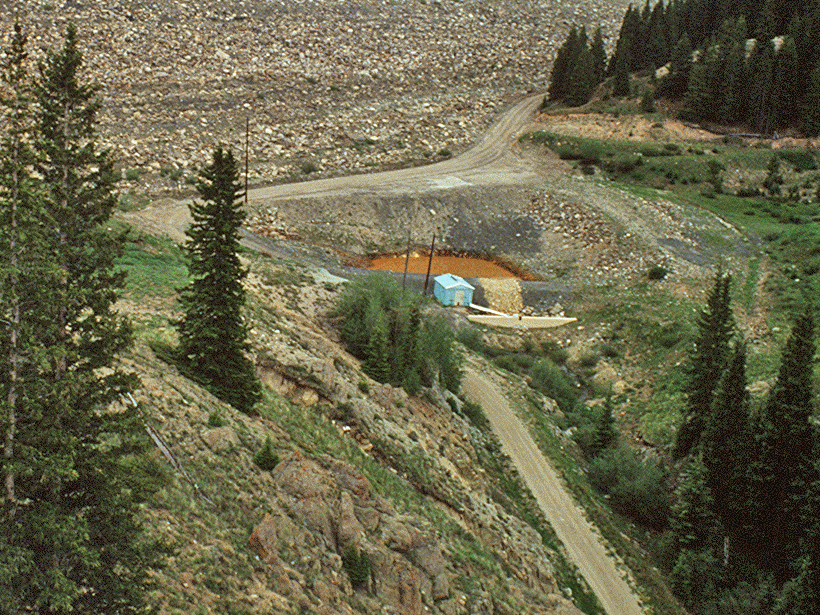“You would put this as a barrier, exactly like your Brita filter.”
Whether the end product is coal, tar sands oil, or copper, mines generate large quantities of hazardous gunk, known as mine tailings, that has a nasty habit of leaching into groundwater. Now, a new material not too different from ordinary construction concrete is showing promise as an inexpensive and durable means to filter the drippings from pits filled with mine tailings so that only clean water will seep into the ground below.
“You would put this as a barrier, exactly like your Brita filter,” Ryan Holmes told Eos, gesturing at a scale model of a porous gray column made of limestone and cement that somewhat resembled a discolored Rice Krispies treat. Holmes is a civil engineering graduate student at the University of Missouri, Kansas City (UMKC), and one of the developers of the new material.
He discussed the experimental technology earlier this month at the Geological Society of America’s 2015 annual meeting in Baltimore.
Pervious and Reactive
Mining operations dump tailings, sometimes in excess of 2000 tons per day, in tailings storage facilities—sickly ponds rich in chemical reagents, minerals, and excess metals. Because the material Holmes and his colleagues are developing, called pervious reactive concrete (PRC), has a pH of 12.5, it is alkaline enough to alter the solubility of heavy metals that come its way.
The PRC causes those metals to crystallize and clump together within its concrete pores. Research team member John Kevern, who is Holmes’s graduate adviser, told Eos by email that the PRC blocks could eventually be removed from the ground with construction equipment and transported to a reclamation facility that would recycle the heavy metals. Kevern is an associate professor of civil and mechanical engineering at UMKC.
Barrier Innovation
Mines or environmental remediation projects could use the PRC as either a preventative method for protecting clean groundwater from future contamination or as a way of cleaning up already contaminated water near an existing mining site, Holmes explained. “If we could install this at a new mining facility, it definitely could improve the water quality,” he said. “Or use it as an alternative to some existing [remediation] methods.”
Contaminated groundwater is often pumped from wells to aboveground treatment systems, whereas permeable reactive barriers can be installed at the pollution’s source to intercept contaminants before they mingle with clean water. However, both types of treatment are expensive, and permeable reactive barriers tend to break down over time.
The PRC is a different breed of reactive barrier, according to Holmes. Unlike its counterparts, which are typically made from loose materials, the PRC is a solid object that would be likely to have a longer shelf life. It would still decay eventually, but “it would take a significantly longer amount of time,” he predicted.
Because the PRC is made from concrete, added Kevern, it is much cheaper to make than reactive barriers composed of more costly substances like low-density foam and granular zeolite. Consequently, it could find wider use at polluted locations, he said.
Steps Forward
In pilot tests to date, the material has held up against lead, cadmium, and zinc.
Holmes noted that he and his team have so far only worked with miniature models, but they plan to continue developing the PRC toward full functionality. In pilot tests to date, the material has held up against lead, cadmium, and zinc. The researchers plan to test it against trace metals such as arsenic in the future.
The team is also tweaking the materials in the device to make it more effective in removing different kinds of pollutants. They experimented with adding calcium-rich waste from drinking water treatment facilities to the PRC because calcium is known to draw heavy metals from water. However, the original formula proved more effective at filtering water. The team plans to work with other industrial by-products, such as fly ash from coal-fired power plants and slags from metal production, to customize the PRC and lower its environmental footprint, Kevern said.
Geoffrey Plumlee, a research geochemist at the U.S. Geological Survey in Lakewood, Colo., who has studied the environmental and health implications of mine tailings spills, welcomes the prospective improvement. “I’m all in favor of more-creative ways to help put in more passive kinds of treatment systems,” he says. “The passive systems tend, in the long run, to be easier to operate and less expensive.”
—Shannon Kelleher, Writer Intern
Citation: Kelleher, S. (2015), New reactive barrier may protect groundwater from mine waste, Eos, 96, doi:10.1029/2015EO039749. Published on 16 November 2015.
Text © 2015. The authors. CC BY-NC 3.0
Except where otherwise noted, images are subject to copyright. Any reuse without express permission from the copyright owner is prohibited.

